Apple E3092A, E3085A, E3087A, E3088A, E3091A Users Manual
...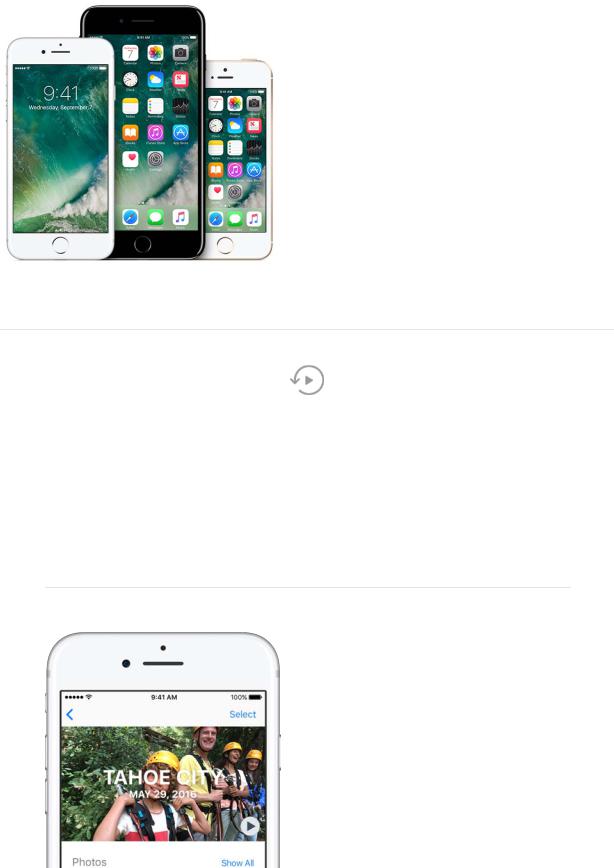
iPhone |
9/7/16, 2)10 PM |
iPhone User Guide
Everything you need to know about iPhone
Remember when?
Rediscover special moments with Memories
Memories takes photos and videos from special times in your life — that crazy race with your best friend, the backpacking trip through Italy, that blurry first year of your sonʼs life — and turns them into short movies.
Get started
Tap the Memories tab in the Photos app and choose a memory. Tap  to play the Memory movie, or scroll down below the movie to see people, places, and other related memories.
to play the Memory movie, or scroll down below the movie to see people, places, and other related memories.
http://help.apple.com/iphone/10/en.lproj/static.html |
Page 1 of 333 |
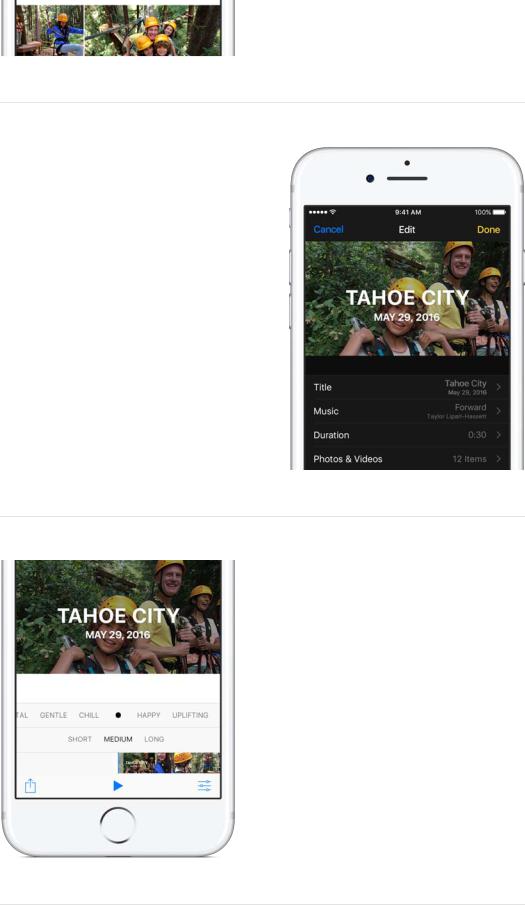
iPhone |
9/7/16, 2)10 PM |
Make it perfect
You can add or remove specific photos and videos, change the soundtrack or title, even adjust the length of the Memory movie. Just tap a Memory movie while itʼs playing, then tap  .
.
Remember together
To share your Memory movie, tap the movie while itʼs playing, tap  , then email it to a friend or send it with Messages. Or, if you have Apple TV, get everyone together and watch on a big screen. All your memories are available in the Photos app on Apple TV when you use iCloud Photo Library.
, then email it to a friend or send it with Messages. Or, if you have Apple TV, get everyone together and watch on a big screen. All your memories are available in the Photos app on Apple TV when you use iCloud Photo Library.
http://help.apple.com/iphone/10/en.lproj/static.html |
Page 2 of 333 |
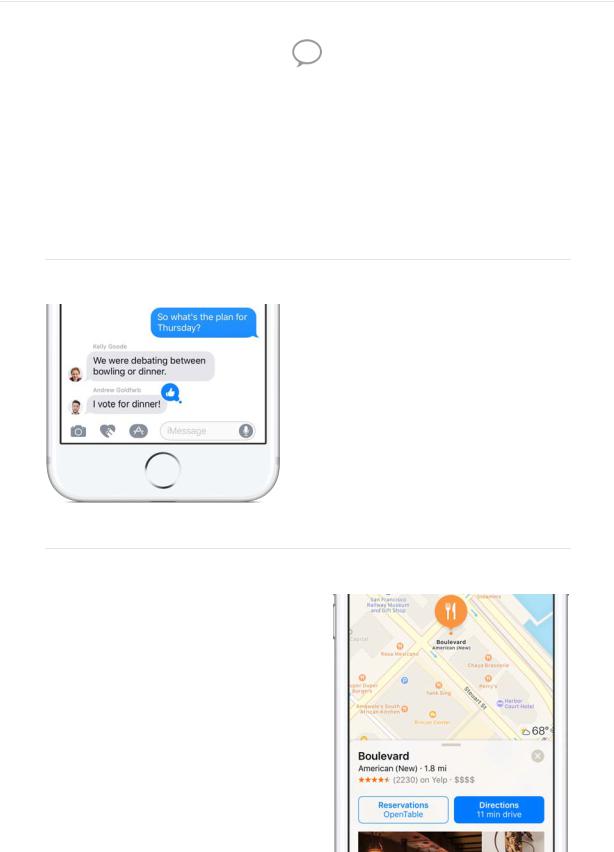
iPhone |
9/7/16, 2)10 PM |
Want to learn more? Check out Memories in Photos.
The gangʼs all here
Use iPhone to plan a night out
Itʼs easy to keep everyone in the loop when you use your iPhone to plan a night out. From tossing around ideas, to finding a restaurant, to arranging transportation, iPhone has you covered.
Make a plan
Start a group conversation in Messages and begin brainstorming potential activities. When someone hits on a plan you love, respond with a Tapback. Double-tap the message, then give it a thumbs up.
Reserve a table
In Maps, pinch open to zoom in on the area you want to search. Tap the search field, tap Food, then tap Restaurants.
After reading up on a few spots, choose one and tap Reservations. If you donʼt see a reservation option, just tap  to give them a call.
to give them a call.
http://help.apple.com/iphone/10/en.lproj/static.html |
Page 3 of 333 |

iPhone |
9/7/16, 2)10 PM |
Call your ride
When itʼs almost time to go, choose your destination in Maps. Tap Directions, tap Ride, then request a ride through an app.
Running late?
Share your location with your friends so they know youʼre on your way. In a Messages conversation, tap  , then tap Send My Current Location.
, then tap Send My Current Location.
Want to learn more about what you can do in Messages and Maps? Start with Find places in Maps, or Messages at a glance.
http://help.apple.com/iphone/10/en.lproj/static.html |
Page 4 of 333 |
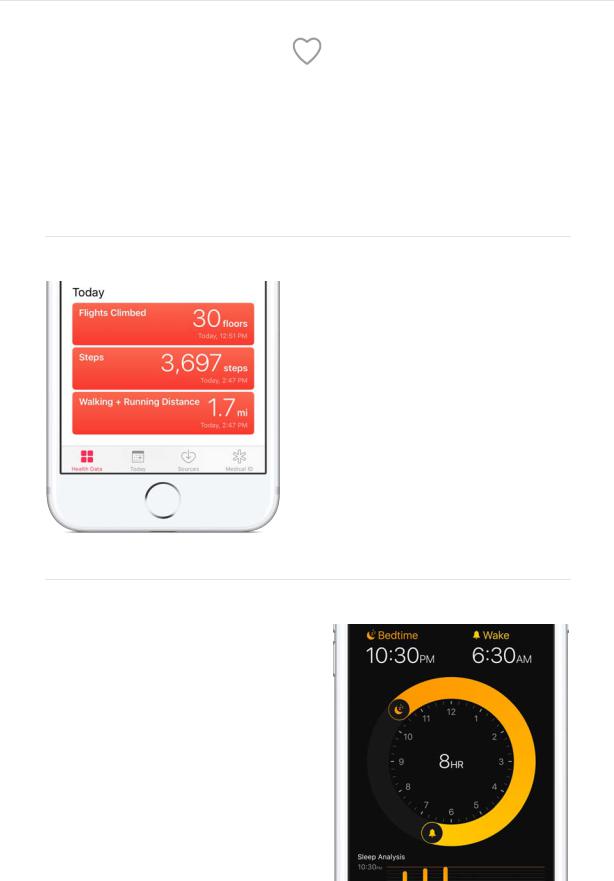
iPhone |
9/7/16, 2)10 PM |
Not all features are available in all areas.
Be well
Create habits that support your health and well-being
Move more, sleep better, or schedule some uninterrupted time. Use iPhone to support your goals for a healthier body and mind.
Steps count
Carry iPhone with you to track how far you walk or run each day. To check your progress, open the Health app, then tap Activity. To see how many steps youʼve traveled over time, tap Steps, then tap Week, Month, or Year.
Sleep better
Use Bedtime in the Clock app to help you build healthy sleep habits by consistently going to bed and waking at the same time. Tap Bedtime, then follow the onscreen instructions.
http://help.apple.com/iphone/10/en.lproj/static.html |
Page 5 of 333 |

iPhone |
9/7/16, 2)10 PM |
Unwind
Enjoy a family dinner, write in your journal, or just sit quietly without interruptions from alerts or notifications. Swipe up from the bottom of the screen to open Control Center, then turn on Do Not Disturb  . To schedule daily quiet time, go to Settings > Do Not Disturb.
. To schedule daily quiet time, go to Settings > Do Not Disturb.
Want to learn more about using iPhone to support your health and wellbeing? Start with Your health at a glance.
Welcome
Set up and get started Whatʼs new in iOS 10 Basics
Personalize your iPhone Apps
Sharing
iPhone and other devices Privacy and security
Restart, update, reset, and restore
http://help.apple.com/iphone/10/en.lproj/static.html |
Page 6 of 333 |
iPhone |
9/7/16, 2)10 PM |
Accessibility
Safety, handling, and support
http://help.apple.com/iphone/10/en.lproj/static.html |
Page 7 of 333 |
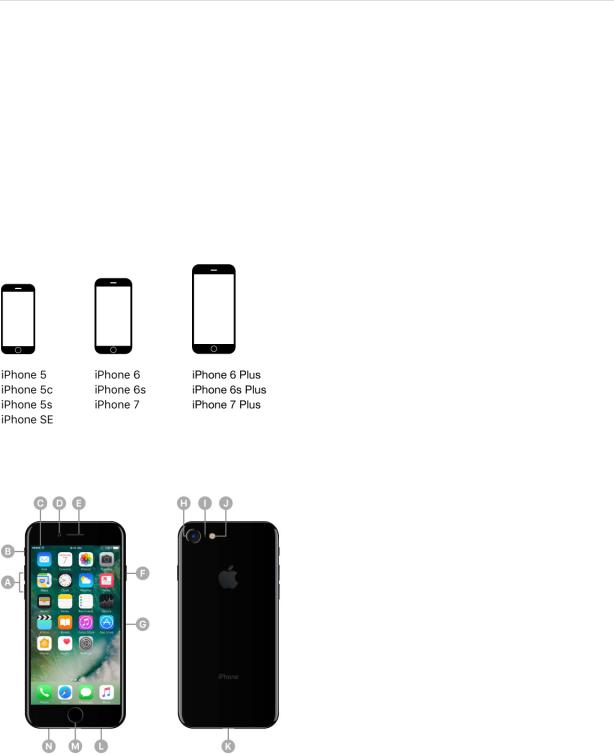
iPhone |
9/7/16, 2)10 PM |
Set up and get started
A quick look at iPhone
iPhone overview
This guide describes iOS 10 for:
iPhone 7
http://help.apple.com/iphone/10/en.lproj/static.html |
Page 8 of 333 |
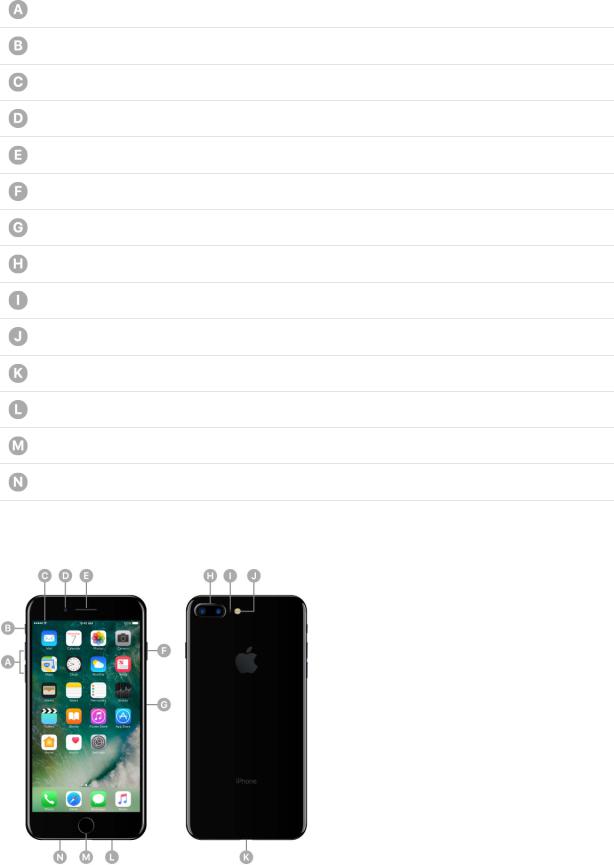
iPhone |
9/7/16, 2)10 PM |
iPhone 7 features
Volume buttons
Ring/Silent switch
Status bar
FaceTime camera
Receiver/microphone/speaker
Sleep/Wake button
SIM card tray
iSight camera
Rear microphone
True Tone Flash
Lightning connector
Speaker/microphone
Home button/Touch ID sensor
Microphone
iPhone 7 Plus
http://help.apple.com/iphone/10/en.lproj/static.html |
Page 9 of 333 |
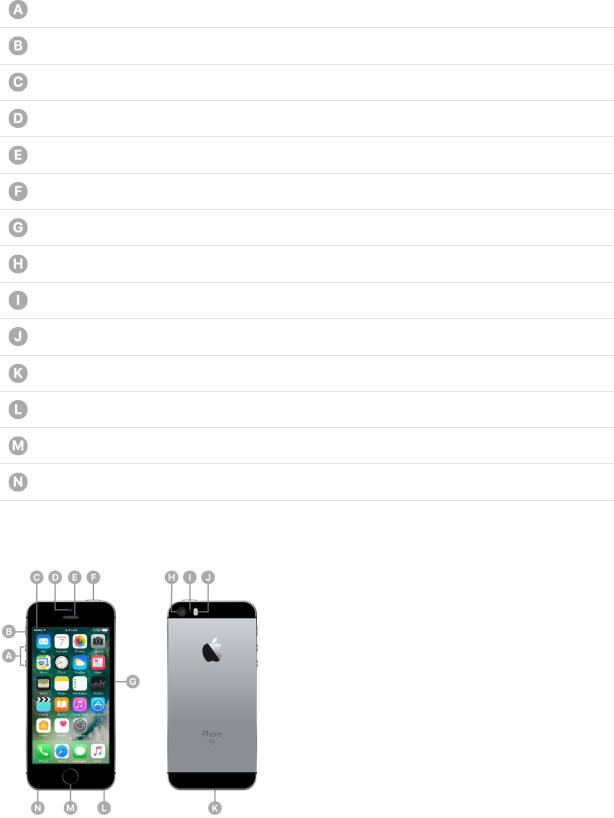
iPhone |
9/7/16, 2)10 PM |
iPhone 7 Plus features
Volume buttons
Ring/Silent switch
Status bar
FaceTime camera
Receiver/microphone/speaker
Sleep/Wake button
SIM card tray
Dual 12MP wide-angle and telephoto cameras
Rear microphone
True Tone Flash
Lightning connector
Speaker/microphone
Home button/Touch ID sensor
Microphone
iPhone SE
http://help.apple.com/iphone/10/en.lproj/static.html |
Page 10 of 333 |

iPhone |
9/7/16, 2)10 PM |
iPhone SE features
Volume buttons
Ring/Silent switch
Status bar
FaceTime camera
Receiver/front microphone
Sleep/Wake button
SIM card tray
iSight camera
Rear microphone
True Tone Flash
Lightning connector
Speaker
Home button/Touch ID sensor
Headset jack
Your features and apps may vary depending on the model of iPhone you have, and on your location, language, and carrier. To learn which features are available on your iPhone, see the Compare iPhone models website. To find out which features are supported in your area, go to the iOS Feature Availability website.
Note: Apps and services that send or receive data over a cellular network may incur additional fees. Contact your carrier for information about your iPhone service plan and fees.
http://help.apple.com/iphone/10/en.lproj/static.html |
Page 11 of 333 |
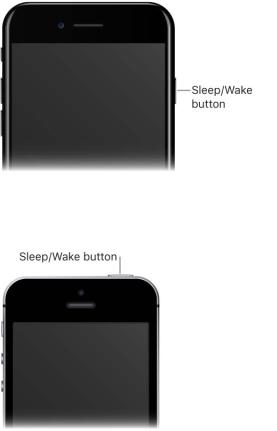
iPhone |
9/7/16, 2)10 PM |
Sleep/Wake button
Use the Sleep/Wake button to turn on or wake iPhone, lock it, or turn it off. Locking iPhone puts the display to sleep, saves the battery, and prevents anything from happening if you touch the screen. You can still listen to music and adjust the volume using the buttons on the side of iPhone, and you can receive phone calls and FaceTime calls, text messages, alarms, notifications, and other updates.
On iPhone 7, iPhone 7 Plus, iPhone 6s, iPhone 6s Plus, iPhone 6, and iPhone 6 Plus, the Sleep/Wake button is on the right side:
On iPhone SE, iPhone 5s, iPhone 5c, and iPhone 5, the Sleep/Wake button is on the top edge:
iPhone locks automatically if you donʼt touch the screen for a minute or so. To adjust the timing, go to Settings > Display & Brightness > Auto-Lock.
Turn on iPhone. Press and hold the Sleep/Wake button until the Apple logo appears.
Turn off iPhone. Press and hold the Sleep/Wake button until the slider appears, then drag the slider.
Wake iPhone. On iPhone 6s and later, lift iPhone, or press the Sleep/Wake or Home button to see the Lock screen. To turn Raise to Wake on or off, go to
Settings > Display & Brightness. On iPhone 6 and earlier, press either the Sleep/Wake or
http://help.apple.com/iphone/10/en.lproj/static.html |
Page 12 of 333 |
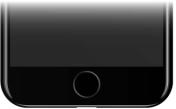
iPhone |
9/7/16, 2)10 PM |
Home button to see the Lock screen.
From the Lock screen you can check notifications and recent app activity, take photos, and more. For more information, see Lock screen.
Unlock iPhone. On iPhone 5s and later, wake iPhone, then press the Home button. On iPhone 5c and iPhone 5, wake iPhone, press the Home button, then enter the passcode if required.
Set a passcode. For additional security, you can require a passcode to unlock iPhone. If you didnʼt create a passcode during setup, go to Settings > Touch ID & Passcode (iPhone 5s and later) or Settings > Passcode (other models).
Home button
The Home button takes you to the Home screen, where you can tap an app to open it. The Home button also provides other convenient shortcuts.
Go to the Home screen. Press the Home button.
Choose the click thatʼs right for you. On iPhone 7 and iPhone 7 Plus, go to Settings > General > Home Button, then choose a click.
See apps youʼve opened. Double-click the Home button when iPhone is unlocked to show the app switcher, then swipe left or right. See Switch between apps.
Use Siri or Voice Control. Press and hold the Home button. See Make requests and Voice Control.
On iPhone 5s and later, you can use the sensor in the Home button to unlock iPhone or make purchases in the iTunes Store, App Store, and iBooks Store (instead of using your passcode or Apple ID password). On iPhone 6 and later, you can also use the Touch ID sensor when using Apple Pay (in countries where Apple Pay is supported) to make a purchase. See Touch ID and About Apple Pay.
You can also use the Home button to turn accessibility features on or off. See Accessibility Shortcut.
http://help.apple.com/iphone/10/en.lproj/static.html |
Page 13 of 333 |
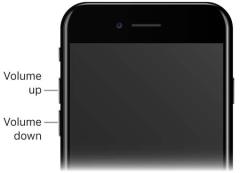
iPhone |
9/7/16, 2)10 PM |
Volume controls
When youʼre on the phone or listening to songs, movies, or other media, the buttons on the side of iPhone adjust the audio volume. Otherwise, the buttons control the volume for the ringer, alerts, and other sound effects. You can also use Siri to turn the volume up or down. Just say “Turn up the volume” or “Turn down the volume.”
WARNING: For information about avoiding hearing loss, see Important safety information.
Lock the ringer and alert volumes. Go to Settings > Sounds & Haptics (called Sounds on iPhone models other than iPhone 7 and iPhone 7 Plus), then turn off Change with Buttons. To limit the volume for music and videos, go to Settings > Music > Volume Limit.
Note: To limit the maximum headset volume, go to Settings > Music > Volume Limit. To prevent changes to the volume limit, go to Settings > General > Restrictions > Volume Limit.
Use Control Center to adjust the volume. When iPhone is locked or when youʼre using another app, swipe up from the bottom edge of the screen to open Control Center, swipe left, then adjust the volume.
You can also use either volume button to take a picture or record a video.
Lightning connector
Connect your Lightning to USB Cable to the Lightning connector to charge or sync your iPhone. For more information about charging, see Charge and monitor the battery. For more information about syncing, see Sync with iTunes.
On iPhone 7 and iPhone 7 Plus, use EarPods with Lightning Connector to listen to audio, or Lightning to Headphone Jack Adapter to connect headphones or other types of devices with a 3.5 mm jack.
http://help.apple.com/iphone/10/en.lproj/static.html |
Page 14 of 333 |
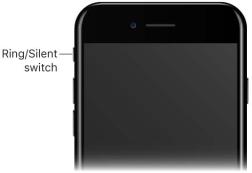
iPhone |
9/7/16, 2)10 PM |
Ring/Silent switch
Flip the Ring/Silent switch to put iPhone in ring mode  or silent mode
or silent mode  .
.
In ring mode, iPhone plays all sounds. In silent mode (switch shows orange), iPhone doesnʼt ring or play alerts and other sound effects (but iPhone may still vibrate).
Important: Clock alarms, audio apps such as Music, and many games play sounds through the built-in speaker, even when iPhone is in silent mode. In some areas, the sound effects for Camera and Voice Memos are played, even if the Ring/Silent switch is set to silent.
For information about changing sound and vibration settings, see Sounds and silence.
Use Do Not Disturb. You can silence calls, alerts, and notifications using Do Not Disturb. Swipe up from the bottom edge of the screen to open Control Center, then tap  .
.
SIM card
If you were given a SIM card to install, install it before setting up iPhone.
Important: A Nano-SIM card is required to use cellular services when connecting to GSM networks and some CDMA networks. iPhone thatʼs been activated on a CDMA wireless network may also use a SIM card for connecting to a GSM network, primarily for international roaming. Your iPhone is subject to your wireless service providerʼs policies, which may include restrictions on switching service providers and roaming, even after conclusion of any required minimum service contract. Contact your wireless service provider for more details. Availability of cellular capabilities depends on the wireless network.
Eject the SIM card tray. Insert a paper clip or the SIM eject tool into the small hole of the SIM card tray on the right side of iPhone, then press firmly to eject and remove the tray. Place the SIM card in the tray—the angled corner determines the correct orientation —then insert the SIM card tray back into iPhone.
http://help.apple.com/iphone/10/en.lproj/static.html |
Page 15 of 333 |

iPhone |
9/7/16, 2)10 PM |
Set a SIM PIN. To protect your SIM card from others using it for phone calls or cellular data, you can use a SIM PIN. With a SIM PIN, every time you restart your device or remove the SIM card, your SIM card locks and you see “Locked SIM” in the status bar. To create one, go to Settings > Phone.
Status icons
The icons in the status bar at the top of the screen give information about iPhone:
Status icon |
What it means |
Cell signal |
Youʼre in range of the cellular network and can |
|
make and receive calls. If thereʼs no signal, “No |
|
service” appears. |
|
|
Airplane Mode |
Airplane Mode is on—you canʼt make phone |
|
calls, and other wireless functions may be |
|
disabled. See Travel with iPhone. |
|
|
LTE |
Your carrierʼs LTE network is available, and |
|
iPhone can connect to the Internet over that |
|
network. (iPhone 5 and later. Not available in all |
|
areas.) See Cellular data settings. |
|
|
UMTS |
Your carrierʼs 4G UMTS (GSM) or LTE network |
|
(depending on the carrier) is available, and |
|
iPhone can connect to the Internet over that |
|
network. (Not available in all areas.) See Cellular |
|
data settings. |
|
|
UMTS/EV-DO |
Your carrierʼs 3G UMTS (GSM) or EV-DO |
|
(CDMA) network is available, and iPhone can |
|
connect to the Internet over that network. See |
|
Cellular data settings. |
|
|
EDGE |
|
http://help.apple.com/iphone/10/en.lproj/static.html |
Page 16 of 333 |

iPhone |
9/7/16, 2)10 PM |
|
Your carrierʼs EDGE (GSM) network is available, |
|
and iPhone can connect to the Internet over that |
|
network. See Cellular data settings. |
|
|
GPRS/1xRTT |
Your carrierʼs GPRS (GSM) or 1xRTT (CDMA) |
|
network is available, and iPhone can connect to |
|
the Internet over that network. See Cellular data |
|
settings. |
|
|
Wi-Fi call |
iPhone is set up for Wi-Fi calling. iPhone also |
|
displays a carrier name next to the icon. See |
|
Make a call. |
|
|
Wi-Fi |
iPhone is connected to the Internet over a Wi-Fi |
|
network. See Connect to Wi-Fi. |
|
|
Do Not Disturb |
Do Not Disturb is turned on. See Do Not Disturb. |
|
|
Personal Hotspot |
iPhone is providing a Personal Hotspot for |
|
another device. See Personal Hotspot. |
|
|
Syncing |
iPhone is syncing with iTunes. See Sync with |
|
iTunes. |
|
|
Network activity |
Shows that thereʼs network activity. Some third- |
|
party apps may also use it to show an active |
|
process. |
|
|
Call Forwarding |
Call Forwarding is set up. See Call forwarding, |
|
call waiting, and caller ID. |
|
|
VPN |
Youʼre connected to a network using VPN. See |
|
VPN settings. |
|
|
TTY |
iPhone is set to work with a TTY machine. See |
|
Support for TTY. |
|
|
Portrait orientation lock |
The iPhone screen is locked in portrait |
|
orientation. See Change the screen orientation. |
|
|
Alarm |
An alarm is set. See Alarms and timers. |
|
|
Location Services |
An item is using Location Services. See Location |
|
Services. |
|
|
Bluetooth® |
Blue or white icon: Bluetooth is on and paired |
|
with a device. |
http://help.apple.com/iphone/10/en.lproj/static.html |
Page 17 of 333 |

iPhone |
9/7/16, 2)10 PM |
|
Gray icon: Bluetooth is on. If iPhone is paired |
|
with a device, the device may be out of range or |
|
turned off. |
|
No icon: Bluetooth is turned off. |
|
See Bluetooth devices. |
|
|
Bluetooth battery |
Shows the battery level of a paired Bluetooth |
|
device. |
|
|
Battery |
Gray icon: Shows the iPhone battery level or |
|
charging status. See Charge and monitor the |
|
battery. |
|
Yellow icon: Low Power Mode is on. See Low |
|
Power Mode. |
|
|
Accessories included with iPhone
The following accessories are included with iPhone:
Apple headset. EarPods with Lightning Connector (included with iPhone 7 and iPhone 7 Plus) or EarPods with 3.5 mm Headphone Plug (included with earlier iPhone
models). Use the headset to listen to music and videos, and make phone calls. See Use your Apple EarPods.
Lightning to Headphone Jack Adapter. Use the Lightning to Headphone Jack Adapter to connect headphones or other devices that have a 3.5 mm headphone plug.
Connecting cable. Use the Lightning to USB Cable to connect iPhone to your computer to sync and charge.
http://help.apple.com/iphone/10/en.lproj/static.html |
Page 18 of 333 |
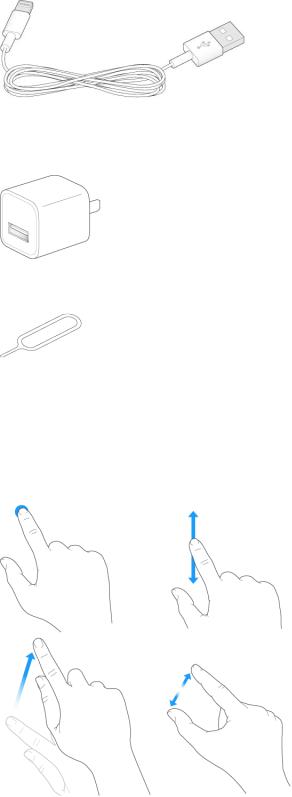
iPhone |
9/7/16, 2)10 PM |
Apple USB power adapter. Use with the Lightning to USB Cable to charge the iPhone battery.
SIM eject tool. Use to eject the SIM card tray. (Not included in all areas.) See Sim Card.
Gestures
A few simple gestures—tap, drag, swipe, and pinch—are all you need to use iPhone and its apps.
http://help.apple.com/iphone/10/en.lproj/static.html |
Page 19 of 333 |

iPhone |
9/7/16, 2)10 PM |
3D Touch
3D Touch gives you an additional way to interact with iPhone. On supported devices, you can press the display to see previews, access useful shortcuts, and more.
3D Touch is supported on:
iPhone 7
iPhone 7 Plus
iPhone 6s
iPhone 6s Plus
For example, press a notification on the Lock screen to respond to it. In Mail, press a message in the mailbox list for a peek at the message contents, then slide up to see a list of actions. Or press a little deeper to pop the message open. In Photos, press an image to peek at it, then swipe up to share or copy it; press a little deeper to pop the image to full screen. In this document, look for other examples of 3D Touch, which are marked with  .
.
You can use 3D Touch on the Home screen—press an app icon to see Quick Actions menus. For example, you can press the Camera icon on the Home screen, then choose Take Selfie. Quick Actions work in Control Center too. For example, press Flashlight, then choose bright, medium, or low light.
http://help.apple.com/iphone/10/en.lproj/static.html |
Page 20 of 333 |
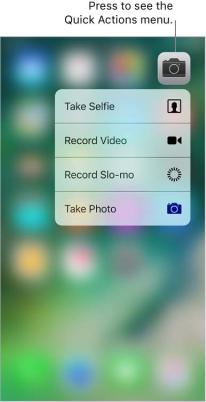
iPhone |
9/7/16, 2)10 PM |
With 3D Touch you can vary the pressure when you draw to change the quality of your lines in some apps. For example, press as you draw in Notes to make a line darker. You can also use 3D Touch to turn your keyboard into a trackpad and select text when typing.
Change 3D Touch sensitivity. Go to Settings > General > Accessibility > 3D Touch, then set 3D Touch sensitivity to Light, Medium, or Firm.
Apple ID
Your Apple ID is the account you use for just about everything you do with Apple— including storing your content in iCloud; downloading apps from the App Store; streaming from Apple Music; buying music, movies, and TV shows from the iTunes Store; and purchasing books from the iBooks Store.
If you already have an Apple ID, use it when you first set up iPhone, and whenever you need to sign in to use an Apple service. If you donʼt have an Apple ID, you can create one anyplace youʼre asked to sign in—for example, the iTunes Store, the App Store, and the iBooks Store. Itʼs best to have only one Apple ID.
For more information, go to the Apple ID account website.
http://help.apple.com/iphone/10/en.lproj/static.html |
Page 21 of 333 |

iPhone |
9/7/16, 2)10 PM |
Set up iPhone
Setup assistant
WARNING: To avoid injury, read Important safety information before using iPhone.
You can set up iPhone over a Wi-Fi network, or over your carrierʼs cellular network (not available in all areas). You can also set up iPhone by connecting it to a computer and using iTunes.
Note: If youʼre using iPhone with a company, school, or other organization, see iPhone in the enterprise.
Set up iPhone. Turn on iPhone, then follow the setup assistant.
To make setup as smooth as possible, have this information at hand:
The name and password (if applicable) of your Wi-Fi network
The email address and password for your Apple ID
If you donʼt have an Apple ID, you can create one during setup.
Your credit or debit card account information, if you want to add a card to Apple Pay during setup
Apple Pay is compatible with iPhone 6 and later.
A backup of your data if youʼre upgrading from another device (see Back up iPhone with iCloud Backup and Back up iPhone with iTunes)
You can also restore iPhone from an iCloud or iTunes backup or migrate from an Android device during setup.
Note: Find My iPhone—a feature you use to locate your iPhone—is turned on automatically when you sign in with your Apple ID during iPhone setup. See Find My iPhone. Find My iPhone includes a feature called Activation Lock that prevents anyone else from activating and using your iPhone, even if itʼs completely erased. Before you sell or give away your device, you should erase and unlock iPhone so that the next owner can activate it.
http://help.apple.com/iphone/10/en.lproj/static.html |
Page 22 of 333 |

iPhone |
9/7/16, 2)10 PM |
Some carriers let you unlock iPhone for use with their network. To see if your carrier offers this option, see Wireless carrier support and features for iPhone in the United States and Canada. Contact your carrier for authorization and setup information. You need to connect iPhone to iTunes to complete the process. Additional fees may apply. For more information, see the Apple Support article How to unlock your iPhone for use with another carrier.
Move to iOS from Android
During setup you can migrate your content automatically and securely from your Android phone.
Download the Move to iOS app. On your device running Android version 4.0 or later, see the Apple Support article Move from Android to iOS and download the Move to iOS app.
Move your data from Android during setup. When setting up iPhone, on the Apps & Data screen, select Move Data from Android, turn on Wi-Fi on the Android device, open the Move to iOS app on the Android device, then follow the steps.
Note: You can use the Move to iOS app only when you first set up iPhone. If youʼve already finished setup and want to use Move to iOS, you must erase your iOS device and start over, or move your data manually. See the Apple Support article Move content manually from your Android device to your iOS device.
The Settings app
The Settings app is on the Home screen. You use it to configure many iPhone settings. For example, tap Settings, then tap Wallpaper (Settings > Wallpaper) to choose a different background for the Lock screen and Home screen. Among other things, you can use Settings to:
Change your password
Select sounds that play during certain events (when you receive an email message, for example)
Configure privacy controls
Find out how much free storage remains on iPhone
Enable restrictions
http://help.apple.com/iphone/10/en.lproj/static.html |
Page 23 of 333 |

iPhone |
9/7/16, 2)10 PM |
Search for a setting. Open Settings, swipe down to show the Settings field, then enter a term—alert or password, for example.
Set up other mail, contacts, and calendar accounts
iPhone works with Microsoft Exchange, and many of the most popular Internet-based mail, contacts, and calendar services.
For information about setting up a Microsoft Exchange account in a corporate environment, see the Apple Support article Set up Exchange ActiveSync on your iPhone, iPad, or iPod touch.
Set up an account. Go to Settings, choose a setting to configure (Mail, Contacts, or Calendar), tap Accounts, then tap Add Account.
You can add contacts using an LDAP or CardDAV account, if your company or organization supports it. See Add contact accounts.
You can add calendars using a CalDAV calendar account, and you can subscribe to iCalendar (.ics) calendars or import them from Mail. See Use multiple calendars.
Date and time
The date and time are usually set for you based on your location—take a look at the Lock screen to see if theyʼre correct.
Set whether iPhone updates the date and time automatically. Go to Settings > General > Date & Time, then turn Set Automatically on or off. If you set iPhone to update the time automatically, it gets the correct time over the cellular network and updates it for the time zone youʼre in. Some carriers donʼt support network time, so in some areas iPhone may not be able to automatically determine the local time.
Set the date and time manually. Go to Settings > General > Date & Time, then turn off Set Automatically.
Set whether iPhone shows 24-hour time or 12-hour time. Go to Settings > General > Date & Time, then turn 24-Hour Time on or off (it may not be available in all areas).
Language and region
Go to Settings > General > Language & Region to set:
The language for iPhone
http://help.apple.com/iphone/10/en.lproj/static.html |
Page 24 of 333 |

iPhone |
9/7/16, 2)10 PM |
The preferred language order for apps and websites
The region format
The calendar format
Advanced settings for dates, times, and numbers
To add a keyboard for another language, go to Settings > General > Keyboard > Keyboards. For more information, see Use international keyboards.
Connect to the Internet
iPhone connects to the Internet whenever necessary, using a Wi-Fi connection (if available) or your carrierʼs cellular network.
When an app needs to use the Internet, iPhone does the following, in order:
Connects over the most recently used available Wi-Fi network
Shows a list of Wi-Fi networks in range and connects using the one you choose
Connects over the cellular data network, if available
Note: If a Wi-Fi connection to the Internet isnʼt available, apps and services may transfer data over your carrierʼs cellular network, which may result in additional fees. Contact your carrier for information about your cellular data plan rates. To manage cellular data usage, see Cellular data settings.
Connect to Wi-Fi
If  appears at the top of the screen, youʼre connected to a Wi-Fi network. iPhone reconnects when you return to the same location.
appears at the top of the screen, youʼre connected to a Wi-Fi network. iPhone reconnects when you return to the same location.
Configure Wi-Fi. Go to Settings > Wi-Fi, then turn Wi-Fi on or off. (You can also turn WiFi  on or off in Control Center.)
on or off in Control Center.)
Choose a network: Tap one of the listed networks, then enter the password, if required.
Ask to join networks: Turn on Ask to Join Networks to be notified when a Wi-Fi network is available. Otherwise, you must manually join a network when a previously used network isnʼt available.
http://help.apple.com/iphone/10/en.lproj/static.html |
Page 25 of 333 |

iPhone |
9/7/16, 2)10 PM |
Join a closed Wi-Fi network: Tap Other, then enter the name of the closed network. You need to know the network name, security type, and password.
Adjust the settings for a Wi-Fi network: Tap  next to a network. You can set an HTTP proxy, define static network settings, turn on BootP, or renew the settings provided by a DHCP server.
next to a network. You can set an HTTP proxy, define static network settings, turn on BootP, or renew the settings provided by a DHCP server.
Note: Some networks may offer different information.
Forget a network: Tap  next to a network youʼve joined before, then tap Forget This Network.
next to a network youʼve joined before, then tap Forget This Network.
Set up your own Wi-Fi network. If you have an unconfigured AirPort base station turned on and within range, you can use iPhone to set it up. Go to Settings > Wi-Fi, then look for “Set up an AirPort base station.” Tap your base station, and Setup Assistant does the rest.
Manage an AirPort network. If iPhone is connected to an AirPort base station, go to Settings > Wi-Fi, tap  next to the network name, then tap Manage This Network. If you havenʼt yet downloaded AirPort Utility, tap OK to open the App Store, then download it.
next to the network name, then tap Manage This Network. If you havenʼt yet downloaded AirPort Utility, tap OK to open the App Store, then download it.
Connect iPhone to your computer
By connecting iPhone to your computer you can sync content from your computer using iTunes and back up iPhone with iTunes.
To use iPhone with your computer, you need:
A Mac with a USB 2.0 or 3.0 port, or a PC with a USB 2.0 port, and one of the following operating systems:
OS X v10.9 or later with iTunes 12.5 or later
Windows 7 or later with iTunes 12.5 or later
iTunes, available from the iTunes download website
Connect iPhone to your computer. Use the included Lightning to USB Cable.
http://help.apple.com/iphone/10/en.lproj/static.html |
Page 26 of 333 |
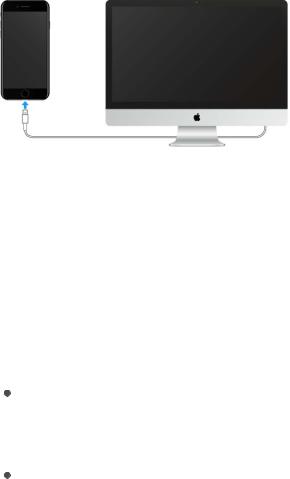
iPhone |
9/7/16, 2)10 PM |
Unless iPhone is actively syncing with your computer, you can disconnect it at any time. Look at the top of the iTunes screen on your computer or on iPhone to see if syncing is in progress. If you disconnect iPhone while itʼs syncing, some data may not get synced until the next time you connect iPhone to your computer.
Manage content on your iOS devices
You can transfer information and files between your iOS devices and computers, using iCloud or iTunes.
iCloud stores your photos and videos, documents, music, calendars, contacts, and more. It all gets pushed wirelessly to your other iOS devices and computers, keeping everything up to date. See iCloud.
iTunes syncs music, videos, photos, and more between your computer and iPhone. Changes you make on one device are copied to the other when you sync. You can also use iTunes to sync files and documents. See Sync with iTunes.
You can use iCloud or iTunes, or both, depending on your needs. For example, you can use iCloud to automatically keep your contacts and calendars up to date on all your devices, and use iTunes to sync music from your computer to iPhone.
You can also manually manage content from iTunes in the Summary pane. To add songs and videos, choose a song, video, or playlist from your iTunes library, then drag it to iPhone in the iTunes sidebar. This is useful if your iTunes library contains more items than can fit on iPhone. See the Apple Support article Sync your iPhone, iPad, or iPod touch with iTunes using USB.
Note: If you have iCloud Music Library turned on, you can manually manage only video.
iCloud
Safely store your photos and videos, documents, music, calendars, contacts, News favorites and saved stories, and more in iCloud so theyʼre available even if you lose your iPhone.
http://help.apple.com/iphone/10/en.lproj/static.html |
Page 27 of 333 |

iPhone |
9/7/16, 2)10 PM |
Set up iCloud. Go to Settings > iCloud. Create an Apple ID if you donʼt have one, or use your existing one.
Content stored in iCloud is pushed wirelessly to your other devices where youʼre signed in to iCloud with the same Apple ID.
iCloud is available on devices with iOS 5 or later, on Mac computers with OS X v10.7.5 or later, and on PCs with iCloud for Windows 5 (Windows 7 or later is required). You can also sign in to iCloud.com from any Mac or PC to access your iCloud information and features like Photos, Find My iPhone, Mail, Calendar, Contacts, iWork for iCloud, and more.
Note: iCloud may not be available in all areas, and iCloud features may vary by area. For more information, go to the iCloud website.
With iCloud you can:
Access your purchases: Automatically get iTunes purchases on all your devices set up with iCloud, or download previous purchases from the iTunes Store, App Store, and iBooks Store for free, anytime.
Access your music: With an Apple Music membership, any music you added from Apple Music is accessible from iPhone. With an iTunes Match subscription, music from your library, including music you imported from CDs or purchased somewhere other than the iTunes Store, can also be stored in iCloud and played on demand.
http://help.apple.com/iphone/10/en.lproj/static.html |
Page 28 of 333 |

iPhone |
9/7/16, 2)10 PM |
Store your photos and videos: Use iCloud Photo Library to store all your photos and videos in iCloud. You can access them from any device with iOS 8.1 or later, a Mac with OS X v10.10.3 or later, a PC with iCloud for Windows 5, and on iCloud.com when you sign in with the same Apple ID. Use iCloud Photo Sharing to share photos and videos with only the people you choose, and let them add photos, videos, and comments.
Note: If you use iCloud Photo Library to store your photos and videos, you canʼt use iTunes to sync them with your computer.
Share with your family: With Family Sharing, up to six family members can share their purchases from the iTunes Store, App Store, and iBooks Store. With an optional Apple Music family membership, all family members can use Apple Music. Pay for family purchases with the same credit card and approve kidsʼ spending right from a parentʼs device. Plus, share photos, a family calendar, and more.
Store and retrieve your documents: Store PDFs in iCloud and access them in iBooks from your iPhone, iPad, iPod touch, Mac, or PC. With iCloud Drive you can safely store your presentations, spreadsheets, images, and other documents in iCloud, and access them from your iPhone, iPad, iPod touch, Mac, or PC. iCloud Drive is available on any device with iOS 8 or later and on any Mac with OS X v10.10.0 or later. If youʼre using an earlier version of iOS, see Set up iCloud Drive.
Synchronize mail, contacts, calendars, and more: Keep your mail, contacts, calendars, notes, and reminders up to date across all your devices.
Note: If you use iCloud to store your contacts and calendars, you canʼt use iTunes to sync them with your computer.
Keep tabs on your browsing: With Safari tabs you can see the tabs you have open on your other iOS devices and Mac computers. See Browse the web.
Keep News up to date across all your devices: Access your favorite News sources and topics as well as the saved stories on all your devices with iOS 9 or later that are set up with iCloud. (News isnʼt available in all areas). See Get started with News.
Back up your data: Back up iPhone to iCloud automatically when iPhone is connected to power and Wi-Fi. iCloud data and backups sent over the Internet are encrypted. See Back up iPhone with iCloud Backup.
Find your iPhone: Locate your missing iPhone on a map, lock it remotely, suspend or remove the ability to pay using Apple Pay, play a sound, display a message, or erase all the data on it. Find My iPhone also includes Activation Lock, which requires your
http://help.apple.com/iphone/10/en.lproj/static.html |
Page 29 of 333 |

iPhone |
9/7/16, 2)10 PM |
Apple ID and password to disable Find My iPhone, erase iPhone, or reactivate your device. See Find My iPhone.
Find your friends: Use Find My Friends to share your location with friends and family.
Store and access your passwords and credit card information: iCloud Keychain keeps passwords and credit card information up to date across all your designated devices.
With iCloud, you get a free email account and 5 GB of storage for your mail, documents, photos and videos, and backups. Your purchased music, apps, TV shows, and books donʼt count against your available storage space. You can increase your iCloud storage by choosing a plan for up to 1 TB of storage. You can purchase additional storage right from your device.
Upgrade your iCloud storage. Go to Settings > iCloud > Storage, then tap Change Storage Plan. For information about upgrading your iCloud storage, see iCloud Help.
View and download previous or shared purchases. You can download purchases from the iTunes Store, App Store, and iBooks Store.
iTunes Store purchases: Go to the iTunes Store, tap More, then tap Purchased. You can also access your purchased songs and videos in the Music and Videos apps. In Music, tap Library. In Videos, tap Movies or TV Shows.
App Store purchases: Go to the App Store, tap Updates, then tap Purchased.
iBooks Store purchases: Go to iBooks, then tap Purchased.
Turn on Automatic Downloads for music, apps, or books. Go to Settings > iTunes & App Store.
For more information about iCloud, go to the iCloud website. For support information, go to the iCloud Support website.
Sync with iTunes
Syncing with iTunes copies information from your computer to iPhone, and vice versa. You can sync by connecting iPhone to your computer, or you can set up iTunes to wirelessly sync music, videos, photos, and more with Wi-Fi. For help syncing iPhone, open iTunes on your computer, choose Help > iTunes Help, then select “Add items to iPod, iPhone, or iPad.” iTunes is available from the iTunes website.
http://help.apple.com/iphone/10/en.lproj/static.html |
Page 30 of 333 |
